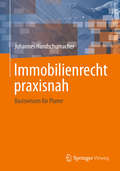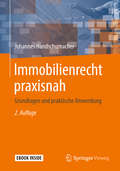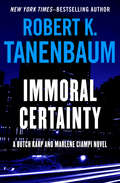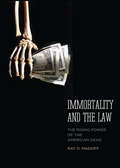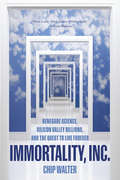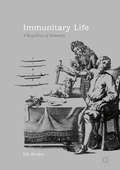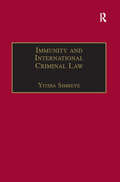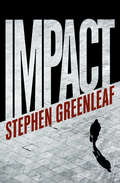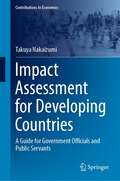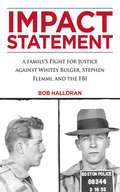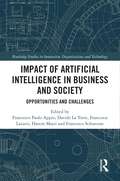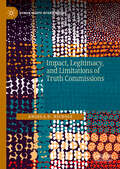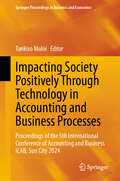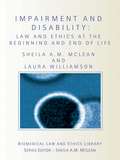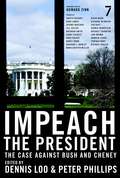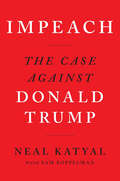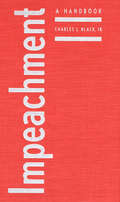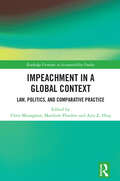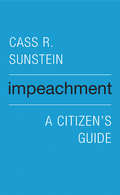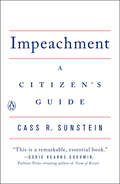- Table View
- List View
Immobilienrecht praxisnah: Basiswissen für Planer
by Johannes HandschumacherPlaner von Gebäuden müssen die wichtigsten Begriffe und Zusammenhänge des Immobilienrechts kennen, denn vor der eigentlichen Planungsphase steht in vielen Fällen ein Grundstücks- oder Immobilienerwerb. Dadurch können sich bauplanungsrechtliche, maklerrechtliche, nachbarschaftsrechtliche und versicherungsrechtliche Fragestellungen ergeben, bei denen der Planer seinen Bauherrn beraten können sollte. Dieses Werk stellt die gesamte Breite des Immobilienrechts mit seinen diversen Teilgebieten in komprimierter und verständlicher Form dar. Es möchte insbesondere dem nichtjuristischen Baupraktiker fundierte Antworten auf immobilienrechtliche Fragestellungen geben.
Immobilienrecht praxisnah: Grundlagen und praktische Anwendung
by Johannes HandschumacherGute Kenntnisse im Immobilienrecht gehören nicht nur für Rechtsanwälte und Juristen in der Ausbildung zum unverzichtbaren Handwerkzeug, sondern auch für solche Berufsgruppen, die sich regelmäßig mit rechtlichen Fragestellungen rund um die Immobilie auseinandersetzen müssen. Für sie ist es unabdingbar, die wichtigsten Begriffe und Zusammenhänge des Immobilienrechts zu kennen, denn sowohl vor der eigentlichen Planungsphase als auch nach der Fertigstellung von Bauvorhaben, steht in vielen Fällen ein Grundstücks- oder Immobilienkauf bzw. -verkauf. Dazu kommen maklerrechtliche, nachbarschaftsrechtliche, versicherungsrechtliche und steuerrechtliche Fragestellungen rund um die Immobilie Dieses Werk erläutert die gesamte Breite des Immobilienrechts mit seinen Teilrechtsgebieten in komprimierter und verständlicher Form. Es will insbesondere auch dem Baupraktiker fundierte Antworten auf immobilienrechtliche Fragestellungen geben.
Immoral Certainty: No Lesser Plea, Depraved Indifference, And Immoral Certainty (Butch Karp and Marlene Ciampi #3)
by Robert K. TanenbaumFrom a New York Times–bestselling master with over one million copies in print: Prosecutor Butch Karp hunts a psychopath targeting the innocent. He is the Bogeyman: a remorseless monster stalking the streets of New York in search of fresh victims—his chosen prey being children. The killings are ghastly enough to shock lawyer Butch Karp, who thought he&’d already seen the absolute worst of humanity in his work. So when a child abuse case and a homicide case seem to be connected, Karp and his colleague Marlene Ciampi find themselves delving into the darkest corners of New York&’s underworld. Their chosen prey? A cold-blooded predator whose twisted work has only just begun—and whose true motives will force Karp to decide how far he is truly willing to go to stop the horror. Known to his fans as &“one hell of a writer,&” (New York Post) Robert K. Tanenbaum lends truthful, gritty authenticity to his legal thrillers as one of the most successful prosecuting attorneys in America, having convicted hundreds of violent criminals. This is one of the most intense and haunting of the popular series that includes Infamy, Tragic, and No Lesser Plea. This ebook features an illustrated biography of Robert K. Tanenbaum including rare photos from the author&’s personal collection.
Immortality and the Law
by Ray D. MadoffThis book takes a riveting look at how the law responds to that distinctly American dream of immortality. While American law provides virtually no protections for the interests we hold most dear--our bodies and our reputations--when it comes to property interests, the American dead have greater control than anywhere else in the world. Moreover, these rights are growing daily. From grave robbery to Elvis impersonators, Madoff shows how the law of the dead has a direct impact on how we live. Madoff examines how the rising power of the American dead enables the deceased to exert control over their wealth forever through grandiose schemes like "dynasty trusts" and perpetual private charitable foundations and to control their creative works and identities well into the unforeseeable future. Madoff explores how the law of the dead can, in essence, extend the reach of life by granting virtual immortality to individuals. All of this comes, Madoff contends, at real costs imposed on the living.
Immortality, Inc.: Renegade Science, Silicon Valley Billions, and the Quest to Live Forever
by Chip WalterThis gripping narrative explores today's scientific pursuit of immortality, with exclusive visits inside Silicon Valley labs and interviews with the visionaries who believe we will soon crack into the aging process and cure death.We live in an age when billionaires are betting their fortunes on laboratory advances to prove aging unnecessary and death a disease that can be cured. Researchers are delving into the mysteries of stem cells and the human genome, discovering what it means to grow old and how to keep those processes from happening. This isn't science fiction; it's real, it's serious, and it's on track to revolutionize our definitions of life and mortality.In Immortality, Inc., veteran science journalist Chip Walter gains exclusive access to the champions of this radical cause, delivering a book that brings together for the first time the visions of molecular biologist and Apple chairman Arthur Levinson, genomics entrepreneur Craig Venter, futurist Ray Kurzweil, rejuvenation trailblazer Aubrey de Grey, and stem cell expert Robert Hariri. Along the way, Walter weaves in fascinating conversations about life, death, aging, and the future of the human race.
Immunitary Life: A Biopolitics of Immunity
by Nik BrownThis book explores the growing intellectual interest in the politics of immunity. It argues that taking an ‘immunitary perspective’ is necessary if we are to better appreciate the body as a site of politics in the contemporary age. It explores the dynamic tensions between community and immunity, belonging and fragmentation, the social and the individual. It creates a dialogue between the social sciences, humanities and biopolitical philosophy around immunity. Immunitary Life empirically situates immunitary politics in real-world debates. This includes blood donation and evolving notions of embodied intimacy in the worlds of transplantation. It examines changing ideas about infectivity, bugs, and the emergence of ‘resistance’ in antibiotics. The politics of vaccination offers a classic context for thinking about the ever changing relationships between the communal and the individual. Immunitary Life is essential reading for contemporary scholarship in the sociology of the body and the political philosophy of biomedicine.
Immunitas: The Protection And Negation Of Life
by Roberto EspositoThis book by Roberto Esposito - a leading Italian political philosopher - is a highly original exploration of the relationship between human bodies and societies. The original function of law, even before it was codified, was to preserve peaceful cohabitation between people who were exposed to the risk of destructive conflict. Just as the human body's immune system protects the organism from deadly incursions by viruses and other threats, law also ensures the survival of the community in a life-threatening situation. It protects and prolongs life. But the function of law as a form of immunization points to a more disturbing consideration. Like the individual body, the collective body can be immunized from the perceived danger only by allowing a little of what threatens it to enter its protective boundaries. This means that in order to escape the clutches of death, life is forced to incorporate within itself the lethal principle. Starting from this reflection on the nature of immunization, Esposito offers a wide-ranging analysis of contemporary biopolitics. Never more than at present has the demand for immunization come to characterize all aspects of our existence. The more we feel at risk of being infiltrated and infected by foreign elements, the more the life of the individual and society closes off within its protective boundaries, forcing us to choose between a self-destructive outcome and a more radical alternative based on a new conception of community.
Immunity and International Criminal Law
by Yitiha SimbeyeTwo events occurred in 1998 that had far-reaching consequences for international justice: the adoption of the Statute for the International Criminal Court by the Diplomatic Conference of Plenipotentiaries in Rome (the Rome Statute); and the arrest in London of former President Pinochet for crimes against humanity. These events are, for many, the culmination of attempts to seek legal redress against those who commit international crimes. This stimulating, ground-breaking book debates the issues raised by international crimes. It highlights the two competing international law needs that must be addressed in this situation: the pursuit of international justice (which international criminal law purports to uphold), and the maintenance of international peace and security - an important rationale for the immunities of state officials abroad.
Immunity to Error through Misidentification
by Simon Prosser François Recanati"Immunity to error through misidentification is recognised as an important feature of certain kinds of first-person judgments, as well as arguably being a feature of other indexical or demonstrative judgments. In this collection of newly commissioned essays, the contributors present a variety of approaches to it, engaging with historical and empirical aspects of the subject as well as contemporary philosophical work. It is the first collection of essays devoted exclusively to the topic and will be essential reading for anyone interested in philosophical work on the self, first-person thought or indexical thought more generally"--
Impact
by Lawrence M. FriedmanUnder what conditions are laws and rules effective? Lawrence M. Friedman gathers findings from many disciplines into one overarching analysis and lays the groundwork for a cohesive body of work in "impact studies." He examines the importance of communication on the part of lawgivers and the nuances of motive among those subject to the law.
Impact
by Stephen GreenleafA legal battle turns violent in the aftermath of a tragic plane crash The fog is thick as SurfAir 617 readies to land. Onboard, a mother consoles her daughter, two children reminisce about Disneyland, flight attendants flirt with each other, and two lovers agonize over their infidelity. None of them know they are minutes from death. Then SurfAir 617 drops out of the sky, the pilots blinded by the fall, and explodes onto the runway. Only eighteen of more than one hundred passengers survive. The families of the victims soon find themselves under siege by ruthless lawyers and corrupt insurance investigators who will do whatever it takes to cheat them out of their rightful settlements. In retaliation, lawyer Keith Tollison dives into the jungle of aviation law—and a fight to prove that SurfAir 617 should never have been cleared to fly.
Impact Assessment for Developing Countries: A Guide for Government Officials and Public Servants (Contributions to Economics)
by Takuya NakaizumiImpact Assessment (IA) is introduced in this book, with a guide to the process, scope, content, and management of IA for the governments of developing economies. In doing so, evidence-based policy making is taken into full consideration. After the principles of IA are set forth, its procedures are described, illustrated by typical cases from the United States and Japan. Then an explanation follows of the components of IA such as necessity, alternatives, and assessment of cost and benefit, with a description of competition assessment. In developing economies, it is not effective to simply import a system from developed countries directly into developing countries, especially for economic regulation and in consideration of compliance and competition issues. Thus the book provides recommendations on how to appropriately modify developed countries’ systems for countries that are still developing. The book concludes by taking up several issues surrounding IA, especially nudge theory and public involvement.
Impact Statement: A Family's Fight for Justice against Whitey Bulger, Stephen Flemmi, and the FBI
by Bob HalloranAs the biggest criminal trial since the Boston Strangler draws nearer, the public's fascination with the life and crimes of mob boss Whitey Bulger continues to heat up. Many stories have been told about the murders Whitey and Stephen "The Rifleman" Flemmi committed, and the tacit permission they received from the FBI. But never before has the story been told from the point of view of one of the victim's families--until now.Impact Statement is the first book to provide background into the family of a victim and their own compelling history and experiences, their decades-old fight for justice, the momentous victory over the US government, and their angry quest for the closure that Bulger's trial may provide.Author Bob Halloran will have front-row access to the trial and the ensuing media blitz, as he observes the trial alongside Steven F. Davis, perhaps the most outspoken advocate for the victims' families. The murder of Davis's sister, Debbie, is what keeps Flemmi jailed to this day, and remains the most horrific and arbitrary killing committed by Bulger and Flemmi.Steven Davis's colorful commentary and reflective admissions of his own criminal past will reveal how he was once a protégé of Flemmi's, and how the Davis family's longstanding relationship with Flemmi cost them a father, two sisters, and a brother. Such is the devastating impact Bulger and Flemmi's violence had not only on their own families, but many others as well.
Impact of Artificial Intelligence in Business and Society: Opportunities and Challenges (Routledge Studies in Innovation, Organizations and Technology)
by Francesco Schiavone Hatem Masri Francesca Lazzeri Francesco Paolo Appio Davide La TorreBelonging to the realm of intelligent technologies, it is increasingly accepted that artificial intelligence (AI) has evolved from being merely a development standpoint in computer science. Indeed, recent reports and academic publications show that we are clearly on the path toward pervasive AI in both business and society. Organizations must adopt AI to maintain a competitive advantage and explore opportunities for unprecedented innovation. This book focuses on understanding the wide range of opportunities as well as the spectrum of challenges AI brings in different business contexts and society at large. The book highlights novel and high-quality research in data science and business analytics and examines the current and future impact of AI in business and society. The authors bridge the gap between business and technical perspectives and demonstrate the potential (and actual) impact on society. Embracing applied, qualitative, and quantitative research as well as field experiments and data analysis, the book covers a broad range of topics including but not limited to human-centered AI, product and process innovation, corporate governance, AI and ethics, organizational performance, and entrepreneurship. This comprehensive book will be a valuable resource for researchers, academics, and postgraduate students across AI, technology and innovation management, and a wide range of business disciplines.
Impact, Legitimacy, and Limitations of Truth Commissions (Human Rights Interventions)
by Angela D. NicholsThis book develops a theoretical understanding of how truth commissions achieve legitimacy and contribute to peace and stability. Angela D. Nichols argues that truth commissions are most likely to impact society when they possess certain institutional characteristics—characteristics that send important political signals to the state and broader society alike. If these signals suggest greater degrees of authority, a break with the past, and transparency in both its investigations and its findings, the truth commission is more likely to impact society. In particular, Nichols examines whether or not states that adopt truth commissions with these characteristics are more likely to respect human rights and experience lower levels of violence. She concludes with an analysis of Colombia’s newly established Truth, Coexistence, and Non-Recurrence Commission.
Impacting Society Positively Through Technology in Accounting and Business Processes: Proceedings of the 5th International Conference of Accounting and Business iCAB, Sun City 2024 (Springer Proceedings in Business and Economics)
by Tankiso MoloiThis conference volume discusses the findings of the iCAB 2024 conference that took place in Sun City, South Africa, on June 27-28 2024. The University of Johannesburg hosted the iCAB 2024 conference with the aim to bring together researchers from different Accounting and Business Management fields to share ideas and discuss how new disruptive technological developments are impacting the field of accounting. The conference was sponsored by the Association of International Certified Professional Accountants AICPA & CIMA.
Impairment and Disability: Law and Ethics at the Beginning and End of Life (Biomedical Law and Ethics Library)
by Sheila McLean Laura WilliamsonThis book explores legislation intended to protect the interests of people with disabilities or impairments. Considering a broad range of ethical and legal concerns which arise in issues of life, death and disability, it covers the social and legal responses to the equality rights of disabled people, focusing on those responses to: the right to life the end of life assisted suicide. This work engages with contemporary debates, examines case studies and explores the problems surrounding many legal concepts within the context of disability and impairment. The authors argue that it is crucial to distinguish between unjust discrimination and differential treatment and unify the disagreements surrounding the issues by highlighting ethical ideals that should be shared by all stakeholders in life and death decisions that impact on people with disabilities. Topical and contemporary, this book is a perfect supplementary text for students of all levels and researchers working in the areas of law, applied ethics and disability theory.
Impeach the President: The Case Against Bush and Cheney
by Dennis Loo Peter PhillipsArticles witten by many authors citing the reasons why President George Bush shuld be impeaced.
Impeach the President: The Case Against Bush and Cheney
by Howard Zinn Dennis Loo Peter PhillipsThis brilliantly argued and wonderfully written collection by twenty-two of the best political analysts in the US analyzes the extraordinary and unprecedented threat the White House and its allies present to civil liberties, civil rights, the Constitution, international law, and the future of the planet. Impeach the President unearths the stories behind election fraud in 2000 and 2004, the overt lies used to justify pre-emptive war on Iraq, the extensive, ongoing commission of war crimes and torture, the tragic failures in the lead-up to and aftermath of Hurricane Katrina, and lesser-known but equally alarming offences of propaganda and disinformation, illegal spying, environmental destruction, and the violation of the separation of church and state. Loo and Phillips chillingly reveal the full threat behind the radical right-wing force that has taken over the world's most powerful office.
Impeach: The Case Against Donald Trump
by Neal Katyal Sam KoppelmanAn acclaimed Supreme Court lawyer and former Acting Solicitor General argues why impeachment is the only remedy for the dangers posed by President Trump.No one is above the law. This belief is as American as freedom of speech and turkey on Thanksgiving—held sacred by Democrats and Republicans alike. But as the celebrated Supreme Court Lawyer and former acting solicitor general Neal Katyal argues in Impeach, if President Trump is not held accountable for repeatedly asking foreign powers to interfere in the 2020 presidential election, this could well mark the end of our democracy. After all, as President George Washington said in his Farewell Address: “Foreign influence is one of the most baneful foes of our republican government.”Impeachment should always be our last report, explains Katyal, an “extreme centrist,” but our founders, our principles, and our Constitution leaves us with no choice but to impeach President Trump—before it’s too late.An instant New York Times bestseller.
Impeachment
by Charles Black" In a classic guide to presidential impeachment, Charles L. Black clarifies the issues and questions that surround this controversial subject. With a new foreword by constitutional expert Akhil Reed Amar, this authoritative book is essential reading for every concerned citizen. "The best essay written on the subject."—Jeffrey Rosen, New Republic "[Black's] timely volume clearly and lucidly covers everything from what constitutes "high crimes and misdemeanors" to the scope of Executive privilege. . . . The measure of his book's achievement is that it tells the reader not what to think but what to think about."—Time "A citizen's guide to impeachment. . . . Elegantly written, lucid, intelligent, and comprehensive."—Mary Ann Gale, New York Times Book Review "Black's survey is a dispassionate, invaluable beam of light. . . . This everyman's guide to impeachment outlines the process leading to the removal of a President by Congress, places it in historical perspective, [and] discusses the conundrums that spring from it. . . . It provides a major contribution to sanity in our government."—Newsweek "A model of how so serious an act of state should be approached."—Wall Street Journal "
Impeachment in a Global Context: Law, Politics, and Comparative Practice (Routledge Frontiers in Accountability Studies)
by Aziz Z. Huq Chris Monaghan Matthew FlindersThis volume considers the use of impeachment within a global context. The book brings together leading scholars and experts to give an insight into significant periods in the development of impeachment and its modern comparative use. Divided into five parts, the opening chapter introduces the topic and underlines its significance in terms of understanding the relationship and inter-dependence among politics, governance and the law. It also offers a novel conceptual framework that facilitates the global mapping of impeachment processes. Part I presents a thematic approach that explores the topic of impeachment through the lenses of democracy, human rights and the rule of law. With these themes in mind, Part II focuses on those parts of the world where impeachment is generally recognised as a core constitutional process including the United States, South Korea, Brazil and other countries in South America. Part III continues with the process of constitutional mapping by moving to a focus on those countries where impeachment is arguably an important but largely secondary or peripheral process. This includes chapters on Denmark, Iceland, Sri Lanka and the Philippines and flows through into Part IV’s focus on areas of the world where impeachment matters and may even be increasing in terms of visibility but, for a number of reasons, arguably exists within a satellite status in terms of constitutional processes and safeguards. The fifth and final section steps back in an attempt to assess impeachment processes from a broad comparative perspective. The collection presents the definitive text on impeachment for students and scholars with an interest in comparative public law, politics and constitutional studies.
Impeachment: A Citizen's Guide
by Cass R. Sunstein“Sunstein has written the story of impeachment every citizen needs to know. This is a remarkable, essential book.” — Doris Kearns Goodwin As Benjamin Franklin famously put it, Americans have a republic, if we can keep it. Preserving the Constitution and the democratic system it supports is the public’s responsibility. One route the Constitution provides for discharging that duty—a route rarely traveled—is impeachment. Cass R. Sunstein provides a succinct citizen’s guide to an essential tool of self-government. He illuminates the constitutional design behind impeachment and emphasizes the people’s role in holding presidents accountable. Despite intense interest in the subject, impeachment is widely misunderstood. Sunstein identifies and corrects a number of misconceptions. For example, he shows that the Constitution, not the House of Representatives, establishes grounds for impeachment, and that the president can be impeached for abuses of power that do not violate the law. Even neglect of duty counts among the “high crimes and misdemeanors” delineated in the republic’s foundational document. Sunstein describes how impeachment helps make sense of our constitutional order, particularly the framers’ controversial decision to install an empowered executive in a nation deeply fearful of kings. With an eye toward the past and the future, Impeachment: A Citizen’s Guide considers a host of actual and imaginable arguments for a president’s removal, explaining why some cases are easy and others hard, why some arguments for impeachment have been judicious and others not. In direct and approachable terms, it dispels the fog surrounding impeachment so that Americans of all political convictions may use their ultimate civic authority wisely.
Impeachment: A Citizen's Guide
by Cass R. Sunstein“With insight, wisdom, affection, and concern, Sunstein has written the story of impeachment every citizen needs to know. This is a remarkable, essential book.” —Doris Kearns GoodwinAn essential guide to the impeachment process that rises above politics and goes beyond punditry, from one of America's foremost legal experts, including analysis of the Mueller Report.As Benjamin Franklin famously put it, Americans have a republic, if we can keep it. Preserving the Constitution and the democratic system it supports is the public's responsibility. One route the Constitution provides for discharging that duty--a route rarely traveled--is impeachment.Harvard Law professor Cass R. Sunstein provides a succinct citizen's guide to this essential tool of self-government. Taking us deeper than mere partisan politics, he illuminates the constitutional design behind impeachment and emphasizes the people's role in holding presidents accountable. In spite of the loud national debate between pundits and politicians alike over whether or not to impeach Trump, impeachment remains widely misunderstood. Sunstein identifies and corrects a number of common misconceptions. For example, he shows how the Constitution, not the House of Representatives, establishes grounds for impeachment, and that the president can be impeached for abuses of power that do not violate the law. Even neglect of duty counts among the "high crimes and misdemeanors" delineated in the republic's foundational document. Sunstein describes how impeachment helps make sense of our constitutional order, particularly the framers' controversial decision to install an empowered executive in a nation deeply fearful of kings.With an eye toward the past and the future, Impeachment: A Citizen's Guide considers a host of actual and imaginable arguments for a president's removal, explaining why some cases are easy and others hard, why some arguments for impeachment have been judicious and others not. And with an appendix on the Mueller report, it puts the current national debate in its proper historical context. In direct and approachable terms, it dispels the fog surrounding impeachment so that Americans of all political convictions may use their ultimate civic authority wisely.
Impeachment: A Handbook
by Philip Bobbitt Charles L. BlackCharles L. Black Jr.’s classic guide to presidential impeachment, now in an updated edition with new material by Philip Bobbitt Originally published at the height of the Watergate crisis and reissued in 1998, two months before the second impeachment of a U.S. president, Charles Black’s Impeachment became the premier guide to the subject of presidential impeachment. Now thoroughly updated, it is essential reading for every concerned citizen.
